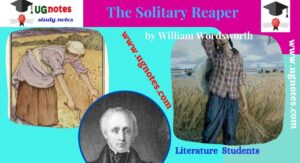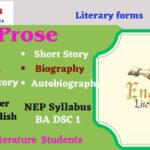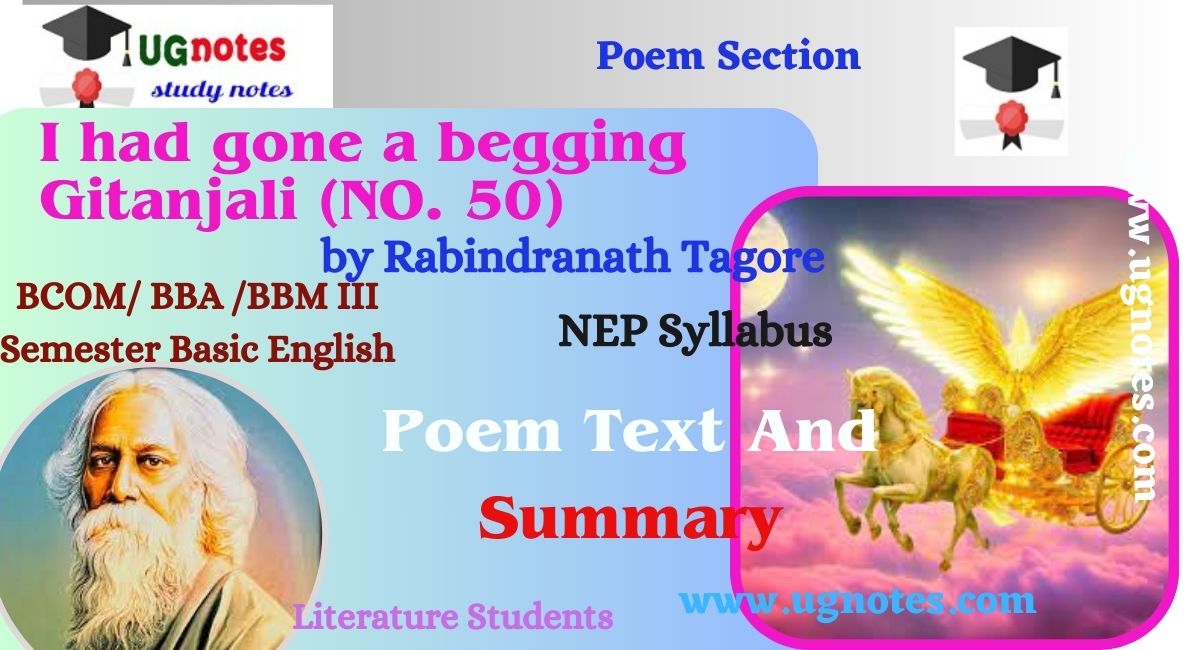State Universities NEP Syllabus, English Literature
The Solitary Reaper, by William Wordsworth
Poem and Summary
The Solitary Reaper
by William Wordsworth
About the poet :
William Wordsworth was born in Cockermouth, Cumberland, England, on April 7, 1770. He was the second of five children born to John Wordsworth, a lawyer and rent collector, and his wife, Anne. The children lost their mother in 1778, and at age nine, the boy was sent to a local grammar school near Windermere, England. The setting figures are in the first two books of The Prelude. He was orphaned by age 13, and his education came under the care of his uncles.
In 1787, he entered Cambridge University, where he began writing poetry. While studying at Cambridge, he embarked on a long walking tour of France and Switzerland, especially the Alpine regions, which also figure in The Prelude.
Poem Text
Behold her, single in the field.
Yon solitary Highland Lass!
Reaping and singing by herself
Stop here, or gently pass!
Alone, she cuts and binds the grain.
And sings a melancholy strain;
O listen! for the Vale profound
Is overflowing with the sound.
No nightingale ever chaunted
So sweetly to reposing bands
Of travelers in some shady haunt,
Among Arabian Sands:
No sweeter voice was ever heard
In spring, from the Cuckoo-bird,
Breaking the silence of the seas
Among the farthest Hebrides.

Will no one tell me what she sings?
Perhaps the plaintive numbers flow
For old, unhappy, far-off things,
And battles long ago:
Or is it some more humble lay?
Familiar matter of today?
Some natural sorrow, loss, or pain
That has been and may be again!
What’s the theme, The Maiden sang
As if her song could have no ending,
I saw her singing at her work.
And o’er the sickle bending;
I listened till I had my fill.
And, as I mounted up the hill,
The music in my heart bores me.
Long after it was heard, no more.
Summary :-
The ballad of 32 lines was published in Poems in Two Volumes. It has four stanzas of eight lines following ABAB CCDD, except for the irregular first and third stanzas. There, the first and third lines are in a type of imperfect rhyme, for example, rhyming “field” and “herself,” which makes the poem stand apart from other ballads.
The poem narrates a chance encounter in the Scottish Highlands with a woman working in the fields to harvest grain. She sings in the local Scottish dialect a particular and haunting song that is incomprehensible to the listener and the speaker. The song is all the more memorable to him since it is so mysterious. It seems to remind him of far-off lands and events, though he has no idea why or how. The simplicity of the woman and her song make a deep impression on the speaker, and he feels respect for her work and her peace with herself and with nature. He passes her by, taking the memory with him.
The ballad is essentially romantic for the impact on the senses and memory of something exotic and unknowable. It is typical of Wordsworth’s poetry, embodying his famous description of “emotion recollected in tranquility.” From a time removed from direct experience, he recalls an event that actually happened to a friend, Thomas Wilkinson, as if it were his own. The woman alone at her constant work also calls back something deep from her past, or that of her people, and makes of it something beautiful.
In the busy world that the poet often despised in his works, such truthful and pure moments of beauty are rare. It is not he who sings or even hears her sing, but there is a type of companionship and sharing among all three people—the original listener, the singer, and himself—that is deeply felt and meaningful.
Wordsworth often wrote of solitary figures, outcasts, orphans, and even the disabled in some way. In his general questioning and frequent rejection of traditional society, Wordsworth looked for figures such as the singing, working woman he never saw to represent a purer way of being. His all-encompassing imagination could make something as humble and unknown as the “melancholy strain” the woman sings the material for his own poetry. It’s interesting to note that he never actually describes the song or attempts to say what it sounds like, except that it is “thrilling” and “plaintive.” Only the impression of it counts, and it is up to the reader to ponder and, perhaps, make beauty out of it in turn.











